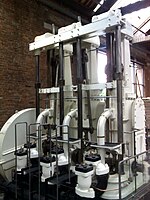Threlfalls Brewery
Defunct breweries of the United KingdomGrade II listed buildings in the City of Salford

Threlfalls Brewery is a Grade II listed building on Cook Street, Salford, England, built in 1896 to the design of W.A. Deighton for Chester's Brewery Company.The brewery premises, comprising two-storey offices, copper room, maturing room, single-storey boiler room, chimney and five-storey tower, were built in pressed red brick with ashlar dressings and Welsh slate roofs.
Excerpt from the Wikipedia article Threlfalls Brewery (License: CC BY-SA 3.0, Authors, Images).Threlfalls Brewery
Cook Street, Salford City Centre
Geographical coordinates (GPS) Address Nearby Places Show on map
Geographical coordinates (GPS)
| Latitude | Longitude |
|---|---|
| N 53.4845 ° | E -2.2537 ° |
Address
Cook Street
M3 7BE Salford, City Centre
England, United Kingdom
Open on Google Maps









